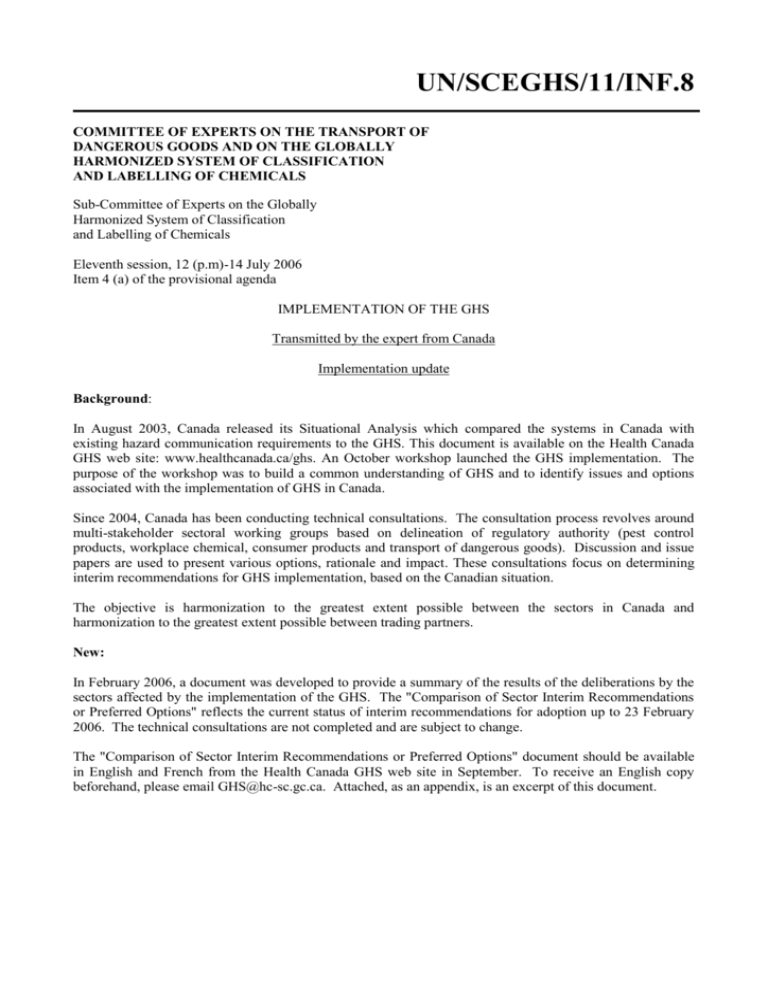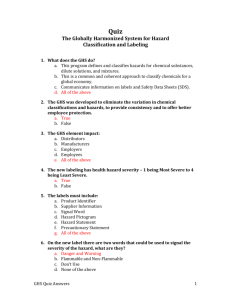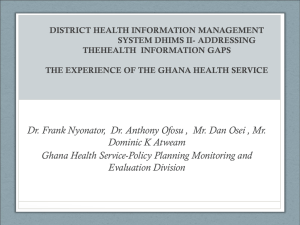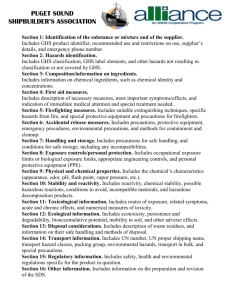un/sceghs/11/inf.8
advertisement

UN/SCEGHS/11/INF.8 COMMITTEE OF EXPERTS ON THE TRANSPORT OF DANGEROUS GOODS AND ON THE GLOBALLY HARMONIZED SYSTEM OF CLASSIFICATION AND LABELLING OF CHEMICALS Sub-Committee of Experts on the Globally Harmonized System of Classification and Labelling of Chemicals Eleventh session, 12 (p.m)-14 July 2006 Item 4 (a) of the provisional agenda IMPLEMENTATION OF THE GHS Transmitted by the expert from Canada Implementation update Background: In August 2003, Canada released its Situational Analysis which compared the systems in Canada with existing hazard communication requirements to the GHS. This document is available on the Health Canada GHS web site: www.healthcanada.ca/ghs. An October workshop launched the GHS implementation. The purpose of the workshop was to build a common understanding of GHS and to identify issues and options associated with the implementation of GHS in Canada. Since 2004, Canada has been conducting technical consultations. The consultation process revolves around multi-stakeholder sectoral working groups based on delineation of regulatory authority (pest control products, workplace chemical, consumer products and transport of dangerous goods). Discussion and issue papers are used to present various options, rationale and impact. These consultations focus on determining interim recommendations for GHS implementation, based on the Canadian situation. The objective is harmonization to the greatest extent possible between the sectors in Canada and harmonization to the greatest extent possible between trading partners. New: In February 2006, a document was developed to provide a summary of the results of the deliberations by the sectors affected by the implementation of the GHS. The "Comparison of Sector Interim Recommendations or Preferred Options" reflects the current status of interim recommendations for adoption up to 23 February 2006. The technical consultations are not completed and are subject to change. The "Comparison of Sector Interim Recommendations or Preferred Options" document should be available in English and French from the Health Canada GHS web site in September. To receive an English copy beforehand, please email GHS@hc-sc.gc.ca. Attached, as an appendix, is an excerpt of this document. UN/SCEGHS/11/INF.8 page 2 Current status: Where are we now? J F M A M J 2004 2005 2006 J A S O Technical Consultations Technical Consultations Technical Consultations & development of Interim Recommendations Next steps: Consultation on implementation phase-in options Consultation with trading partners Economic analysis Development of final recommendations Decision Making Draft Regulations Regulatory process Phasing in implementation N D UN/SCEGHS/11/INF.8 page 3 Appendix This appendix contains an excerpt of the document “Globally Harmonized System for Classification and Labelling of Chemicals (GHS) implementation in Canada: Comparison of sector interim recommendations or preferred options” Last update: 23 February 2006 Introduction The Globally Harmonized System of Classification and Labelling of Chemicals (GHS) provides a common and coherent basis to define and classify chemical hazards and communicate information on labels and safety data sheets. It also provides the underlying infrastructure for a comprehensive national chemical safety program. After more than a decade of development, the GHS was endorsed at the World Summit on Sustainable Development in August 2002 and formally adopted by the United Nations Committee of Experts on the Transport of Dangerous Goods and the GHS in December 2002. The four key sectors in Canada that will be most affected by the implementation of the GHS are: pest control products, workplace chemicals, consumer chemical products and products regulated under the transportation of dangerous goods. Guiding principles of GHS implementation in Canada: (a) Harmonization to the greatest extent possible between the sectors. (b) Harmonization to the greatest extent possible between NAFTA countries and other trading partners. This document This document provides a summary of the results of the deliberations by the sectors affected by the implementation of the GHS, consumer chemicals, pest control products, workplace chemicals and products subject to transportation of dangerous goods as denoted in the charts by the abbreviations: CC, PCP, WHMIS and TDG. The document reflects the current status of preferred options for adoption (indicated by "yes") up to the specified date, i.e. 23 February 2006. The technical consultations are not completed. These results are subject to change. The document is formatted to allow comparison of hazard information communication between the sectors and the GHS. Information for comparisons with trading partners is not yet available. Technical consultations The technical consultation for GHS implementation is through sectoral working group meetings using discussion and issue papers to present various options, rationale and impact. These consultations focus on determining interim recommendations for GHS implementation, based on the Canadian situation. The interim recommendations may be re-visited based on further discussion with trading partners and recommendations made in other sectors. The key pieces of legislation and regulations include: Hazardous Products Act (PART I), Consumer Chemicals and Containers Regulations, 2001 Hazardous Products Act (PART II), Controlled Products Regulations (for work place chemicals / WHMIS) UN/SCEGHS/11/INF.8 page 4 Pest Control Products Act, Pest Control Products Regulations Transportation of Dangerous Goods Act, 1992, Transportation of Dangerous Goods Regulations Transport Canada does not have a sectoral working group, but is proceeding according to the timeline set out by the United Nations Sub-committee of Experts on Transport of Dangerous Goods. The Transportation of Dangerous Goods Regulations follows the United Nations Recommendations on the Transport of Dangerous Goods, Model Regulations. Therefore, the adoption of GHS is harmonized internationally, and in accordance with the UNRTDG Model Regulations. In the case of workplace chemicals, the WHMIS Working Group (WWG) is a working group of the larger WHMIS Current Issues Committee (CIC). Please refer to Appendix 1 for further detail on the consultation process in WHMIS as well as additional hazard information that pertains to WHMIS. Appendix 2 further describes the situation for pest control products. It is recognized that for several of the physical hazard classes, products that meet the hazard classification criteria are not expected to be used as pest control products; however, the Pest Management Regulatory Agency is proposing to adopt these classes as placeholders in the event that such products are manufactured as pest control products. The Consumer Chemicals Sector Working Group serves as a forum for open discussion and advice on matters concerning the implementation of the GHS as it relates to consumer chemical products. In addition to the sectoral working groups, expert groups have been addressing specific issues of environmental and chronic hazard classification and labelling. The draft GHS Situational Analysis, posted on www.healthcanada.ca/ghs, provides a description of the current hazard classification and communication requirements in each sector and those of the GHS. UN/SCEGHS/11/INF.8 page 5 Last update: 23 February 2006 PHYSICAL HAZARDS Flammable Liquids GHS Category 1 Category 2 Flashpoint <23 °C Initial Boiling Pt <35 °C Flashpoint <23 °C Initial Boiling Pt >35 °C Category 3 Flashpoint >23 °C and < 60 °C Category 4 Flashpoint >60 °C and < 93 °C No symbol Danger Danger Warning Warning Extremely flammable liquid and vapour Highly flammable liquid and vapour Flammable liquid and vapour Combustible liquid CC Yes Yes Yes No* PCP Yes Yes Yes Yes TDG Yes Yes Yes** No WHMIS*** Yes Yes Yes Yes * As per 28 June 2005 Consumer Chemical Sector Working Group meeting and comments ** The current TDG cut point for Category 3 is 60.5 °C but this will be changed to 60 °C in Amendment Schedule 6 *** For Mixtures: The WHMIS Current Issues Committee recommended that the mathematical formula not be included in the proposed amendments to the WHMIS regulations (Controlled Products Regulations) upon GHS implementation. UN/SCEGHS/11/INF.8 page 6 Last update: 23 February 2006 HEALTH HAZARDS Acute Toxicity: Oral (mg/kg) Category 1 Category 2 Category 3 Category 4 Category 5 LD50 ≤ 5 LD50≤ 50 LD50≤ 300 LD50≤ 2000 LD50 ≤ 5000 No symbol GHS Danger Danger Danger Warning Warning Fatal if swallowed Fatal if swallowed Toxic if swallowed Harmful if swallowed May be harmful if swallowed CC Yes Yes Yes Yes Pending additional information PCP Yes Yes Yes Yes No TDG* Yes Yes Yes No No WHMIS ** Yes Yes Yes Still under discussion Pending additional information * This shows the requirements of the 14th Revised Edition of the UN Model Regulations and will be reflected in a future amendment to TDG ** For mixtures: The WHMIS Current Issues Committee recommended the incorporation of bridging principles and formulae to calculate the acute toxicity estimate (ATE) be included in the proposed amendment to the WHMIS regulations (Controlled Products Regulations) upon GHS implementation. UN/SCEGHS/11/INF.8 page 7 Last update: 23 February 2006 Acute Toxicity: Inhalation - Vapours (mg/l) Category 1 Category 2 Category 3 Category 4 LC50 ≤ 0.5 LC50 ≤ 2.0 LC50 ≤ 10.0 LC50 ≤ 20.0 Category 5 1 No symbol GHS Warning May be harmful if inhaled Danger Danger Danger Warning Fatal if inhaled Fatal if inhaled Toxic if inhaled Harmful if inhaled CC Yes Yes Yes Yes Yes PCP Yes Yes Yes Yes No TDG Yes Yes Yes Yes* No WHMIS** Yes Yes Yes Still under discussion Pending additional information 1 Guidance on Category 5 Inhalation Values: The OECD Task Force on Harmonization of Classification and Labelling (HCL) did not include numerical values for acute inhalation toxicity Category 5 but instead specified doses "equivalent" to the range of 2000-5000 mg/kg bodyweight by the oral or dermal route. * TDG regulates to 5000 ppm for the inhalation of toxic vapours. The TDG label for Category 4 is skull & crossbones. The WHMIS Current Issues Committee recommended eliminating the existing saturated vapour concentration (SVC) from the WHMIS classification criteria for this hazard class. ** UN/SCEGHS/11/INF.8 page 8 Last update: 23 February 2006 Skin Corrosion/Irritation Category 1A Category 1B Category 1C Category 2 Category 3 Warning GHS Danger Danger Warning Causes severe skin burns and eye damage Causes severe skin burns and eye damage Causes severe skin burns and eye damage Causes skin irritation CC Yes Yes Yes Yes Pending additional information PCP Yes, Adopt 1A, 1B, 1C as Category 1 Yes Yes TDG Yes Yes No No Yes, Adopt 1A, 1B, 1C as Category 1 Yes Yes WHMIS* * Causes mild skin irritation Danger Yes For Mixtures: The WHMIS Current Issues Committee recommended incorporation of the GHS bridging principles and "non-additivity" approach for classifying untested mixtures. __________





